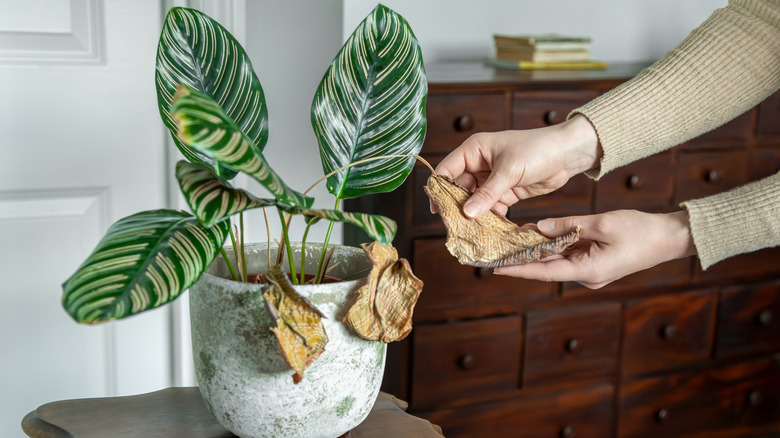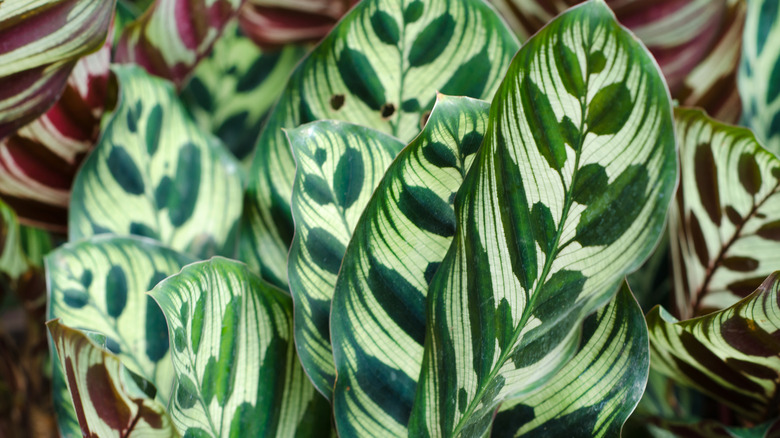The Unique Watering Approach To Keeping Sensitive Calathea Houseplants From Dying
Ah, to be a plant parent. The highs and lows of raising these beloved leaf babies, only to have some give up because of a minor (or major) issue like root rot, dehydration, or just because they didn't like the pot you chose. Sometimes, your plants are more high maintenance than some children and pets, and they can certainly keep you busy when it comes to caring for them. Varieties in the Calathea genus are air-purifying plants you'll want to keep in your home, but they can be finicky. However, Lisa Eldred Steinkopf, Houseplant Guru, and Author of "Houseplants: The Complete Guide to Choosing, Growing, and Caring for Indoor Plants" and several other educational texts on plants, has a clever suggestion on how to properly care for your calatheas so they thrive.
During an exclusive interview with House Digest, Steinkopf explained whether a post on social media by @mariahgrows, who recommends growing these plants in water rather than soil, is a good idea to try. "Calatheas need to be kept moist and by growing them in water, dry plants wouldn't be a problem. And by using distilled or rainwater, it won't have the damaged edges from municipal water that has chemicals in it," she noted.
Steinkopf said she was even considering this trick herself before going on to give more details on why it could work. She explained, "The key to keeping calatheas happy is moisture, humidity, and good light." While finding good lighting and adding a humidifier to your home can check off most of the calathea's boxes, providing enough moisture plays a big role in maintaining them.
Remove soil and submerge roots in water
As the author of the book "Creative Houseplant Projects: Easy Crafts and Growing Tips for Indoor Plants," Lisa Eldred Steinkopf has experience growing houseplants in new and unique ways. Because of this, her exclusive knowledge in an interview with House Digest was invaluable in debunking or proving this method as a good option for keeping calatheas healthy and thriving.
She gives readers instructions on how to apply this trick to eliminate room for error. "Remove as much potting mix as you can and then rinse off any remaining soil [from] the roots of your chosen plant [and] cut off any damaged or dead roots. Place your calathea in your vessel of choice." She also notes that you can get stylish with your vessel. "You may choose to place decorative glass pieces or marbles at the bottom of the vase if it is clear," and while not totally necessary, "These will also help your plant stay upright and not float," Steinkopf adds.
She also explains that the water you use is very important. According to Steinkopf, "Calatheas are sensitive to the fluoride in our tap water, so use distilled or purified water or rainwater." Stating that "The damage from the fluoridated water may include brown spots in the leaves and on the edges." While it may seem high maintenance, this swap might save your calathea from crispy edges.
Keep water levels and type in mind when trying this method
Ensure you maintain the water level in your calathea's vase. If it gets too low, the plant can dry out, leaving yellow leaves that may fall off. However, if the water is too high, it might overwhelm the plant. Steinkopf says, "It is best for the roots only to be under the water. If the leaves are in the water, it may cause problems." She also urges readers to remember that "they need bright light. An east or west window is perfect for them."
During her exclusive interview with House Digest, Lisa Eldred Steinkopf mentioned you may want to use "A diluted fertilizer once a month or so." She discussed the benefits of this method, noting that the "pros are no drying out and more consistent moisture to the plant." As an added bonus, she said this will help with the other environmental factors, like humidity levels. According to Steinkopf, "As the water evaporates it is also raising the humidity around the plant. This helps keep the spider mites at bay, which calatheas are prone to."
However, she also warns that "Algae may grow in the vase. The look of the roots in the vase may not be the look you are going for, so a clear vase may not be the best choice." Keeping the glass totally pristine may be tricky, so keep that in mind when choosing your vessel and the interior additions (like glass or marbles). As one of several indoor plants you can grow in jars, collecting a little algae seems like a small price for a healthy, thriving plant!

